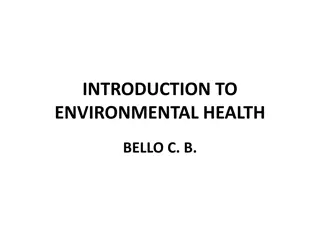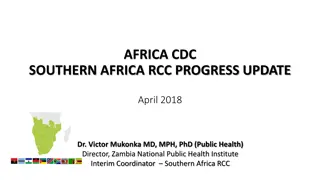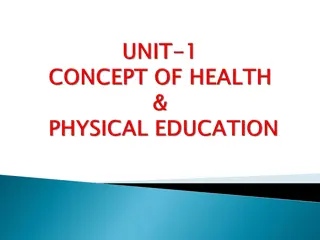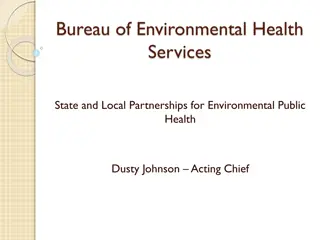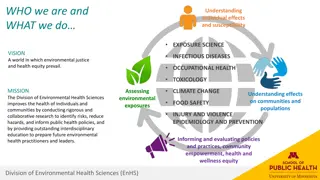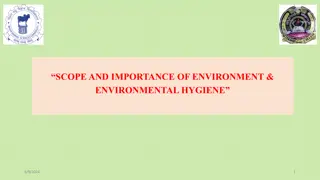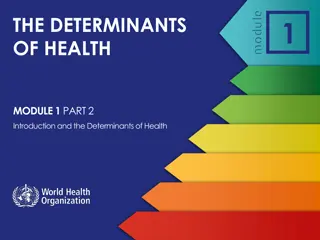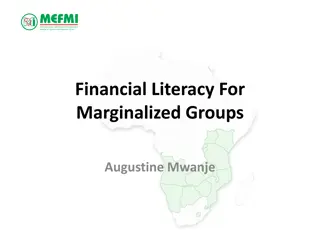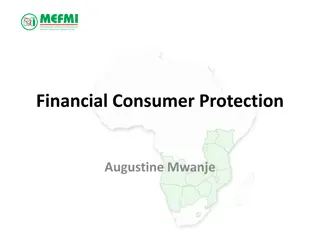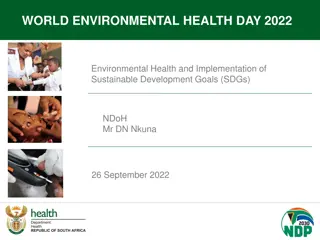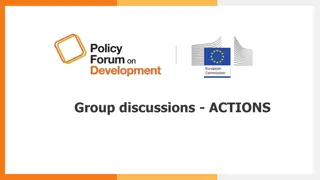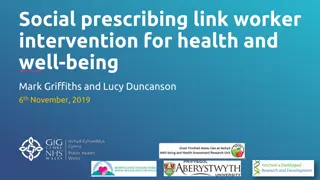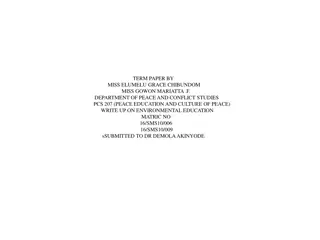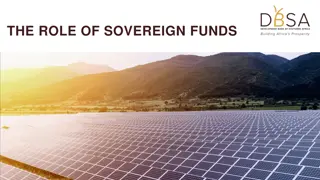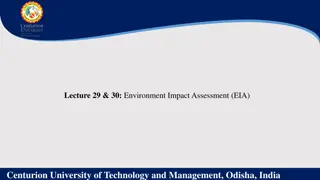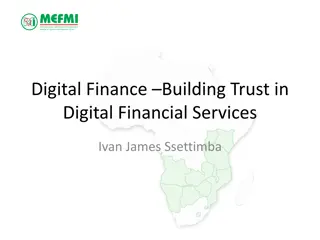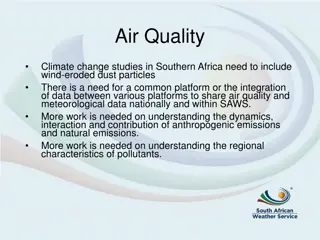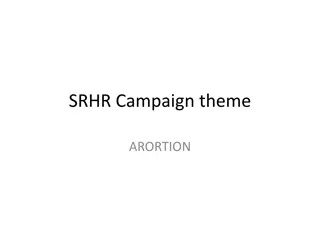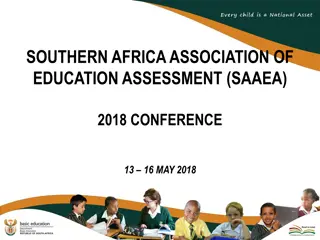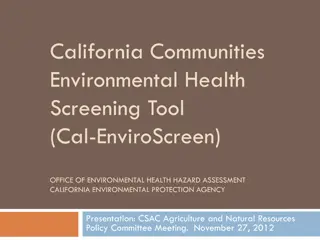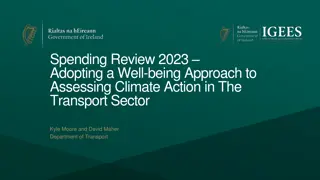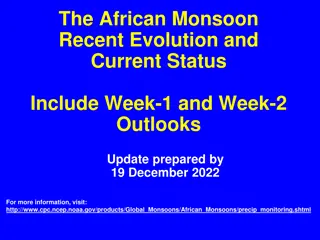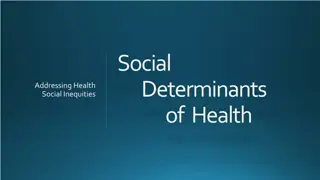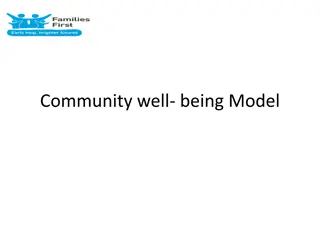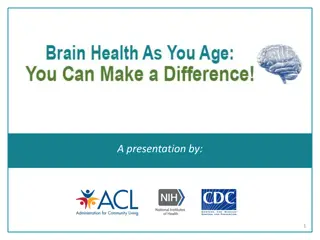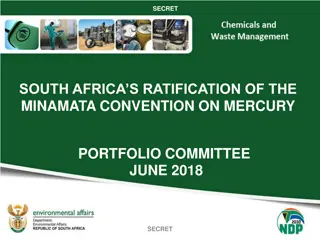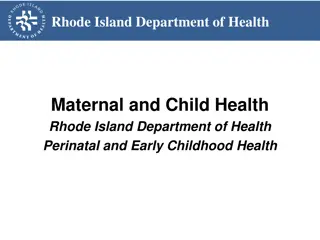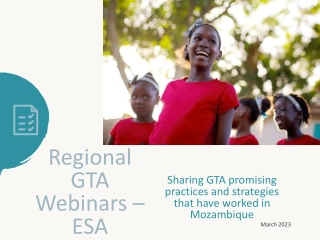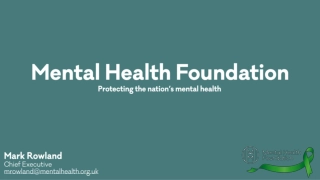CCEHSA Initiatives for Children's Environmental Health and Well-being in Southern Africa
CCEHSA, a nonprofit organization, focuses on improving the health and well-being of disadvantaged children in Southern Africa. By partnering with various stakeholders, they aim to address environmental health challenges faced by children, promote healthy environments, and reduce illness caused by environmental factors. The organization, founded by Amanda Mbikwana, works towards creating a positive impact on children's lives through education, awareness, and advocacy.
Download Presentation

Please find below an Image/Link to download the presentation.
The content on the website is provided AS IS for your information and personal use only. It may not be sold, licensed, or shared on other websites without obtaining consent from the author. Download presentation by click this link. If you encounter any issues during the download, it is possible that the publisher has removed the file from their server.
E N D
Presentation Transcript
SUSTAINABLE DEVELOPMENT GOAL (SGDs): IMPACT TO CHILDREN BY : AMANDAMBIKWANA History will be judge by the difference we make in the everyday lives of children - Nelson Mandela
OUTLINE OUTLINE 1. CCEHSA INTRODUCTION CCEHSAVISION ANDMISSION CCEHSASTRATEGICOBJECTIVES CCEHSAACHIEVEMENTS 2. SDGs : IMPACTTO CHILDREN WHY FOCUSON CHILDREN? SDGs: GOAL 2: ZEROHUNGER GOAL 3: HEALTH& WELL BEING GOAL 6: CLEAN WATER, SANITATIONAND HYGIENE GOAL 7: AFFORDABLEAND CLEAN ENERGY
OUTLINE OUTLINE GOAL 12: RESPONSIBLECONSUMPTIONAND PRODUCTION GOAL 13: CLIMATECHANGE GOAL 14&15: LIFE BELOW WATER ANDLIFE ON LAND CONCLUSION
CCEHSA CCEHSA v CCEHSA a Nonprofit Organization established in 2020, registration number: 246-772 NPO v The organisation caters for ALL children of Southern Africa especially the disadvantaged between the ages of 0-18 in order to bring positive change in their lives by improving their health through providing a platform for engagements and strategy development on environmental health challenges faced by children in the society v CCEHSA through partnership with several interested parties, seeks to change the current existing children s environmental health governance gap v CCEHSA aims to accelerate and amplify environmental health knowledge and practices that affects the children of South Africa v Investing in children's health through promoting awareness on healthy environments for children v CCEHSA aims to reduce ill-health caused by Environmental factors amongst children, and to promote literature about children s environmental health 4
CCEHSA CCEHSA Foundingmembers/Board Members: Mrs. Amanda Mbikwana- Chairperson Mr Sifiso Mbele- Deputy Chair Ms. Junior Tsela- Treasurer Ms. Thero Marule- Board Secretary Mr Joe Shikwambane- Strategy and Policy Ms. Nomsa Thabethe- Advisory committee- Science and Research Advisory Council Member: Advisory Council Member: Dr. Samantha Lange- Training and Development CEH Zimbabwe and Namibia Coordinator: CEH Zimbabwe and Namibia Coordinator: Mr. Stephen Musarapasi Provincial coordinators Provincial coordinators Mr Danie Stander-NC Ms Esther Mahlalela-MP Ms Lindiwe Dhlodhlo-KZN Ms. Andiswa Nqezo-EC 5
CCEHSA VISON AND MISSION CCEHSA VISON AND MISSION VISION: To be a leading Centre of excellence in the Southern African Development Community (SADC) region where fundamental children s environmental health rights are prioritized, realised and achieved MISSION: To provide a platform for strategic development of children s environmental health in Southern Africa
CCEHSA STRATEGIC CCEHSA STRATEGIC v Promote research in children Environmental Health v Promote the concept and knowledge of children s environmental health matters amongst EHP s v Advocate for Children s Environmental health to be included in curricula v Promote knowledge by Early Childhood Developmental Centers and Schools on children senvironmental health matters v Establish partnerships with relevant stakeholders v Fundraising to enable advocacy and promotion of our strategic objectives v Establish an effective communication platform to promote CCEHSA with all identified stakeholders v Identify Provincial coordinators to facilitate our work in all provinces v Identify coordinators in neighbouring countries/Southern Africa
CCEHSA ACHIEVEMENTS: CCEHSA ACHIEVEMENTS: 8
CCEHSA ACHIVEMENTS: CCEHSA ACHIVEMENTS:
CCEHSA ACHIEVEMENTS: CCEHSA ACHIEVEMENTS:
ACHIEVEMENTS: ACHIEVEMENTS:
SDGs: IMPACTS TO CHILDREN SDGs: IMPACTS TO CHILDREN
WHY THE FOCUS ON CHILDREN? WHY THE FOCUS ON CHILDREN? v The environment thus represents a major factor in children s health, with effects seen in every part of the world The key to a peaceful, prosperous, and sustainable world is healthy, safe, and empowered children Children are vulnerable to environmental risks ,creating a safe and healthy environment is one of the essential elements for improving child survival, helping children to thrive, and achieving health equity Global estimates suggest that 26% of all childhood deaths, and a quarter of the disease burden in children aged under five, could be prevented by removing modifiable environmental risks The disease burden linked to the environment also tends to be higher in low- and middle-income countries The United Nations (UN) Sustainable Development Goals (SDGs) encourages an intersectoral approach to resolve the shortcomings of health goals in the Millennium Development Goals and the emerging environmental health challenges SDGs provide strong guidance for governments around the world, to monitor and assess their progress towards creating healthier environments for children The goals target several environmental health risk factors and provide the indicators to measure their status and progress towards reducing these risks v v v v v v v
PROGRESS FOR EVERY CHILD IN THE PROGRESS FOR EVERY CHILD IN THE SDG ERA. UNICEF SDG ERA. UNICEF: : 2019 2019 v The SDGs are universal in scope, their call to leave no one behind puts the world s most vulnerable and marginalized people, including children at the top of the 2030 Agenda v But four years since world leaders committed to achieving the SDGs, are we on track to achieve the goals for children? Do we have enough information to know?
44 CHILD RELATED 44 CHILD RELATED INDICATORS.UNICEF:2019 INDICATORS.UNICEF:2019
INDICATORS ARRANGED INTO 5 INDICATORS ARRANGED INTO 5 DIMENSIONS OF CHILD DIMENSIONS OF CHILD RIGHT.UNICEF, 2019 RIGHT.UNICEF, 2019 v Every child survives and thrives v Every child learns v Every child is protected from violence, exploitation and harmful practices v Every child leaves in a safe and clean environment v Every child has a fair chance in life
GOAL 2: ZERO HUNGER GOAL 2: ZERO HUNGER v The triple burden of malnutrition undernutrition, hidden hunger and overweight threatens the survival, growth and development of children v The greatest burden of all forms of malnutrition is shouldered by children and young people from the poorest and most marginalized communities
SDG 3:HEALTH AND WELLBEING SDG 3:HEALTH AND WELLBEING vReproductive and children s health are cornerstones of Goal 3 vMaternal, prenatal and early childhood periods are particularly vulnerable life stages where environmental hazards can result in premature births and other pregnancy complications, lifelong diseases vIn 2015, a reported 26% of the deaths of 5.9 million children who died before the age of five could have been prevented by addressing environmental risks and hazards v Another major children s environmental health concern is malnutrition, increases the frequency and severity of common infections in children and delays recovery time, leads to stunted growth
SDG 6: CLEAN WATER, SANITATION SDG 6: CLEAN WATER, SANITATION AND HYGIENE AND HYGIENE v Young children are particularly vulnerable, and water and sanitation related diseases remain among the leading causes of death in children under five as well as contribute malnutrition and stunting v Without safe toilets , taps and soap for hand washing, diseases spread rapidly and newborn babies risk death from infection v Every year, 297,000 children under 5 years die due to diarrhea linked to inadequate WASH. v Improving equitable access to water, therefore, underpins the success of all SDGs
SDG 7: AFFORDABLE AND CLEAN SDG 7: AFFORDABLE AND CLEAN ENERGY ENERGY v Sustainable energy is a critical enabler and dramatically improves the quality, accessibility and reliability of services that children rely on for their survival and well-being v The use of biomass fuel is a major source of household air pollution, but access to clean fuels and technologies for cooking and heating can reduce the mortality rate attributed to household air pollution
SDG 12: RESPONSIBLE SDG 12: RESPONSIBLE CONSUMPTION AND PRODUCTION CONSUMPTION AND PRODUCTION v SDG 12 relates to children in two critical ways: 1. Unsustainable and unsafe consumption and production patterns lead to toxic waste and limited resources which unduly harms children s health, development and environments. 2. Years of evidence show that widespread changes in positive societal behavior often begin with children becoming aware of the problems they observe in their own communities.
SDG 13: CLIMATE CHANGE SDG 13: CLIMATE CHANGE v Climate change and environmental degradation are equity issues that undermine the rights of every child especially the most disadvantages v Approximately 1 billion children are at an 'extremely high risk' of the impacts of the climate crisis. v These children experience multiple climate shocks combined with poor essential services such as water, sanitation and healthcare. v As climate change disrupts the environment, children are being forced to grow up in a world that threatens their health, nutrition, education, development, survival and future
SGD 14&15:LIFE BELOW WATER & SGD 14&15:LIFE BELOW WATER & LIFE ON LAND LIFE ON LAND v Children have a right to natural world ,Protecting life below water (SDG 14) and life on land (SDG 15) matters greatly for the health and wellbeing of children now, as well as future generations. v Children rely on land and marine resources for access to safe water, food and air
HOW CCEHSA CAN PLAY A ROLE HOW CCEHSA CAN PLAY A ROLE IN THE IMPLEMENTATION OF SDGs? THE IMPLEMENTATION OF SDGs? IN v To build and enhance partnerships with diverse stakeholders to strengthen the means of implementation SDG awareness building and meaningful participation of children, adolescent and youth to spark action in their communities and holding leaders accountable To plan and implement programs on SDGs that are directly related to children to illustrates the powerful ways in how reaching children with education in schools positively impacts household and community practices Encourages governments to improve climate education, awareness and participation especially among children and adolescents as this will lead to sustainable personal behavior changes including through household energy use, transportation and food choices, recycling and waste reduction behaviors and other climate friendly decision v v v
CONCLUSION CONCLUSION v The SDGs cannot be achieved without the realisation of child rights. As world leaders work to deliver on the 2030 promise children around the globe are standing up to secure their right to good health, quality education, a clean planet and more v The leaders of tomorrow, children s ability to protect the future for us all depends on what we do to secure their rights today v The capacity of nations to grow, innovate, and strengthen depends on a healthy and productive population. Therefore, the large number of children starting life at severe risk threatens all other Sustainable Development Goals. v Environmental health risks to children and the SDGs and these connections require explicit attention in policies and planned actions to Ensure healthy lives and promote wellbeing for all at all ages moving forward


